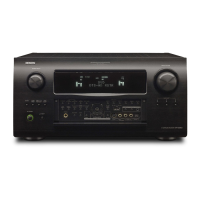
Do you have a question about the Denon AV SURROUND RECEIVER AVR-5308CI and is the answer not in the manual?
| Channels | 7.1 |
|---|---|
| Total Harmonic Distortion (THD) | 0.05 % |
| HDMI Inputs | 6 |
| HDMI Outputs | 2 |
| Signal-To-Noise Ratio | 102 dB |
| Input Sensitivity | 200 mV |
| Tuner Bands | AM/FM |
| HDMI Switching | Yes |
| Digital Audio Inputs (Coaxial) | 3 |
| Ethernet | Yes |
| USB | Yes |
| Frequency Response | 10Hz - 100kHz |
| Audio Formats Supported | Dolby Digital Plus, Dolby TrueHD, DTS-HD Master Audio |
| Weight | 50.7 lbs |
| Response Bandwidth | 10Hz - 100kHz |
| Input Impedance | 47 kOhm |
| Audio D/A Converter | 24bit / 192kHz |
| Dimensions (W x H x D) | 17.1 in x 7.7 in x 19.5 in |
Essential safety instructions for operating the product, covering handling, environment, and usage.
Warnings regarding electric shock, fire hazards, and proper ventilation to ensure safe operation.
Information regarding FCC rules and compliance for US users of the product.
Information regarding Industry Canada rules and compliance for Canadian users.
General notes on using the product and observations for optimal performance.
List of parts supplied with the product for initial setup and operation.
Important guidelines for safe handling, installation, and environmental considerations.
Instructions for inserting batteries into the remote control unit.
Identification and description of buttons, knobs, and indicators on the front panel.
Information on the effective range for operating the unit with remote controls.
Explanation of the various indicators on the unit's display and their meanings.
Detailed diagram and list of all connectors on the rear panel of the unit.
Detailed description of the functions and buttons of the main remote control.
Detailed description of the functions and buttons of the sub remote control.
Illustration and description of various audio cables used for connection.
Illustration and description of various video cables used for connection.
Explanation of how the unit converts video signals for monitor output.
Guidance on speaker placement and connection for optimal surround sound.
Step-by-step instructions for connecting speaker cables to the unit.
Information on the protection circuit and how it activates.
Details on features supported by HDMI connections like Deep Color and xvYCC.
Explanation of HDCP and its role in digital content playback.
Instructions for connecting a display monitor to the unit.
Guide for connecting various audio and video playback sources.
Specific instructions for connecting a DVD player to the unit.
Instructions for connecting record players, CD players, and iPod devices.
Instructions for connecting TV and cable tuners to the unit.
Instructions for connecting satellite receivers to the unit.
Instructions for connecting a digital video recorder for recording.
Instructions for connecting a video cassette recorder for recording.
Instructions for connecting CD recorders, MD recorders, and tape decks.
Connecting devices with a DENON LINK connector for multi-channel audio.
Instructions for connecting video cameras and game consoles.
Connecting components with multi-channel analog outputs.
Instructions for connecting an external power amplifier.
Guide on using the USB ports for connecting external devices.
Instructions for connecting the XM Mini-Tuner and Home Dock.
Instructions for connecting AM and FM antennas for tuner reception.
Instructions for connecting antennas for HD Radio reception.
Instructions for configuring a wired LAN connection for network audio.
Instructions for configuring a wireless LAN connection for network audio.
System requirements for using network audio features.
Instructions for connecting ZONE2/ZONE3 pre-out connectors.
Instructions for connecting ZONE2/ZONE4 optical output connectors.
Instructions for setting up an external controller via RS-232C.
Steps for safely connecting the unit's power cord.
Steps to follow for the first time powering on the unit.
Examples and explanations of various GUI screen displays.
Instructions on how to navigate and operate through the GUI menus.
Overview of the 'Information' section within the GUI menu.
Overview of the 'Parameter' section within the GUI menu.
Overview of the 'Source Select' section within the GUI menu.
Overview of the 'Manual Setup' section within the GUI menu.
Detailed steps for performing the automatic setup procedure.
Necessary preparations and tips before starting the auto setup.
Details on how the unit detects and measures speakers during auto setup.
Steps for calculating, checking, and storing auto setup results.
Common error messages during auto setup and their solutions.
Explanation of option settings like Room EQ and parameter check results.
Guide to setting the size and bass reproduction capability of front/center speakers.
Instructions for configuring subwoofer usage and bass signal playback.
Adjusting channel levels and surround speaker volume for balance.
Using test tones for adjustment and setting subwoofer crossover frequency.
Configuring THX Ultra2 subwoofer settings and Boundary Gain Compensation.
Selecting appropriate surround speaker modes for different content types.
Configuring HDMI color space, RGB range, and auto lip sync.
Selecting HDMI audio output and configuring monitor output.
Enabling and configuring the HDMI control function for device interaction.
Configuring speaker settings for EXT. IN and 2ch Direct/Stereo modes.
Setting downmix options for Dolby Digital and auto surround mode memory.
Adjusting audio tonal quality for each speaker using a graphic equalizer.
Configuring wired/wireless LAN and viewing network status.
Procedure for automatic wireless LAN connection setup.
Procedure for manual wireless LAN connection setup.
Instructions for setting up a proxy server for Internet connection.
Configuration for power saving, GUI background, and other network options.
Configuring trigger outputs based on zone, input source, and surround mode.
Settings for digital outputs and transducer signal output.
Setting Remote ID and configuring 2-way remote control functionality.
Adjusting display brightness and locking settings to prevent changes.
Accessing maintenance functions and updating the unit's firmware.
Information on downloading and upgrading new features.
Selecting the language for on-screen displays.
Procedure for selecting input sources and making related settings.
Configuring settings for TUNER, PHONO, CD, DVD, HDP sources.
Configuring settings for NET/USB, XM, and HD Radio sources.
Configuring video input selection, conversion, and i/p scaling.
Setting resolution, aspect ratio, and input modes for video signals.
Adjusting source level and configuring iPod playback modes.
Assigning input sources to connectors and setting decode modes.
Configuring still picture playback and antenna aiming for NET/USB.
Selecting USB port and adjusting XM antenna aiming.
Explanation of HOME THX CINEMA and Standard playback modes.
Guide to playing back multi-channel audio sources like Dolby Digital and DTS.
Using DSP simulation modes and Dolby Headphone for enhanced audio.
Explanation of Stereo playback modes and their effects.
Introduction to adjusting various audio parameters for playback.
Detailed settings for surround parameters like mode and level.
Adjustments for dynamic range compression, LFE level, and center image.
Settings for panorama effect and cinema equalization.
Settings for auto surround mode and surround back channel output.
Adjusting bass and treble levels for all channels.
Setting room equalization and using the RESTORER function.
Adjusting dynamic equalization and optimizing for late-night listening.
Compensating for mismatched timing between video and audio signals.
Adjusting picture contrast, brightness, and color saturation.
Adjusting picture hue, noise reduction, enhancement, and sharpness.
Displaying status information for the main zone and other zones.
Information on audio/HDMI signals and quick select settings.
Information on preset stations and auto surround mode settings.
Displaying information about the current auto surround mode settings.
Configuring speaker settings specifically for EXT. IN mode playback.
Setting speaker configurations for 2-channel mode playback.
Setting dynamic range for downmix and auto surround mode memory.
Adjusting speaker tonal quality using the graphic equalizer.
Compensating for timing mismatches between video and audio signals.
Displaying information about audio input and HDMI signals.
Displaying information about quick select settings and preset stations.
Displaying information about the currently set auto surround mode.
Procedures for turning the unit on/off and adjusting the master volume.
Using headphones and playing video/audio equipment.
Fundamental steps for playing back media sources.
Step-by-step guide for tuning and listening to FM and AM broadcasts.
Instructions for saving and recalling favorite radio stations.
Using RDS search to find stations and tuning preset stations.
Understanding PTY codes for program types and traffic information.
Detailed procedures for searching stations by Program Type and Traffic Program.
How to view radio text data broadcast from stations.
Getting started with XM Radio, including basic operation and subscription.
How to check XM signal strength and locate the Radio ID.
Accessing XM stations directly and searching by category.
Guide to accessing and listening to HD Radio stations.
How to select different audio programs broadcast with HD Radio.
Viewing reception status and signal information for HD Radio.
Getting started with iPod playback and listening to music.
Using controls for pause, fast forward/reverse, and track skipping.
Playing Internet radio stations and media files from a computer.
Playing music and still picture files stored on a USB memory device.
Prerequisites for network audio playback, including media player software.
Setting up a Rhapsody account and accessing the music guide.
Finding music tracks on Rhapsody through search functions.
Tuning into and saving favorite Internet radio stations.
Adding, viewing, and clearing favorite Internet radio stations.
Operating the unit using a web browser for remote control.
Instructions for playing music, image, and playlist files from USB devices.
Instructions for playing media files stored on a computer via network.
Steps for selecting and listening to Rhapsody music content.
How to search for music tracks and information on Rhapsody.
Instructions for playing Super Audio CD discs.
Procedure for recording audio from one source while listening to another.
How to record audio encoded in Dolby Headphone mode.
Explanation of the HDMI control function for synchronized operations.
Steps for using HDMI control features like power sync and input switching.
Steps to reset the unit's microprocessor if operations fail.
Instructions for operating DENON audio components with the remote.
Guide to preset remote control codes for operating various brands.
How to operate components using preset remote control codes.
Mapping of remote control buttons to functions for different device modes.
Configuring remote ID and learning functions for device control.
Setting up system call sequences and punch through functions.
Instructions for setting the remote control ID for multiple receivers.
Steps to learn remote control signals from other devices.
Registering and calling out sequences of operations for a single button.
Storing TV or SAT/CBL mode buttons for use with other device modes.
Procedures for resetting the remote control unit to default settings.
Adjusting the remote control's backlight and display brightness.
Overview of functions available on the sub remote for different components.
Selecting zones and locking the sub remote to a specific zone.
Configuring Remote ID and resetting sub remote settings.
Setting zone lock mode and remote ID for sub remote control.
Assigning amplifiers to channels for multi-zone and bi-amp playback.
Diagrams for speaker connections and channel output mapping.
Mapping speaker terminals to amp assign modes based on playback settings.
Mapping speaker terminals to amp assign modes based on playback settings.
Summary of amp assign modes and their relation to speaker terminals.
Instructions for turning zones on/off and selecting input sources.
Controlling volume levels and muting audio in multi-zone setups.
Procedures for controlling power for individual zones via remote.
Selecting input sources for specific zones using the remote control.
Controlling volume levels and muting audio for specific zones.
Recommendations for placing surround back speakers for optimal effect.
Illustrations and examples of speaker placement for surround sound.
Explanation of Dolby Digital and Dolby TrueHD audio technologies.
Explanation of the Dolby Digital Plus audio format.
Explanation of various DTS surround sound formats.
Explanation of Dolby Pro Logic and Pro Logic II surround formats.
Explanation of Home THX Cinema mode and Re-Equalization function.
Explanation of the Dolby Headphone technology for immersive sound.
Explanation of Timbre Matching and THX Ultra2 certification.
Details on THX Cinema, Music, and Games modes for optimal playback.
Explanation of ASA technology and Boundary Gain Compensation feature.
Explanation of the THX Surround EX technology for enhanced surround effects.
Explanation of Neural Surround™ and HDCD® technologies.
Information on DENON LINK interface and AL24 Processing technology.
Explanation of Audyssey MultEQ XT room correction and Dynamic EQ.
Overview of HDMI interface standards and features.
Explanation of Deep Color and xvYCC features for video quality.
Explanation of the Lip Sync feature for audio-video synchronization.
Table summarizing surround modes and parameter adjustability.
Details on which parameters are adjustable for each surround mode.
Table showing compatibility between input signals and surround modes.
Detailed mapping of input signals to supported surround modes.
Summary table of parameter adjustability across different surround modes.
Information on Windows Media Player and the vTuner Internet radio service.
Details on wireless LAN standards (Wi-Fi) and security protocols.
Explanation of Infrastructure and Ad-hoc wireless network types.
Information regarding DLNA certification and compatibility.
Explanation of various wireless LAN security protocols and encryption methods.
Table detailing video signal conversion compatibility for the main zone.
Table detailing video signal conversion compatibility for Zone 2 and 3.
Amp assign settings for STEREO and DIRECT modes.
Instructions for turning multi-zone power on and off.
Speaker terminal assignments for 7.1ch playback and free assign modes.
Summary of multi-zone settings and amp assign configurations.
Common issues with unit power, sound, and display, and their solutions.
Troubleshooting common problems with the remote control unit.
Troubleshooting issues related to speaker audio output.
Troubleshooting problems with video display and HDMI connections.
Troubleshooting problems with USB and Internet radio playback.
Troubleshooting common error messages displayed in XM mode.
Technical specifications for the power amplifier and dynamic power output.
Technical specifications for analog and digital input/output sensitivity.
Technical details for wireless LAN standards and general unit specifications.
Technical specifications for remote controls and video connectors.
Technical specifications for the FM/AM tuner and HD Radio reception.
List of preset codes for Denon amplifiers, tuners, and iPod devices.
List of preset codes for cable boxes, HDTV tuners, and satellite receivers.
List of preset codes for CD players and PVRs.
List of preset codes for various satellite receiver brands.
List of preset codes for TV and DVD player combinations.
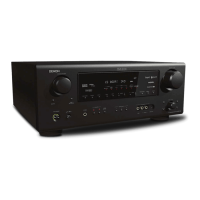
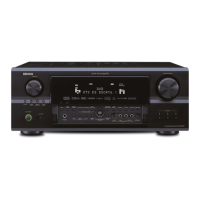

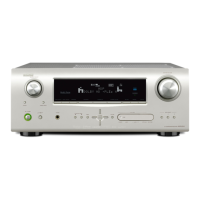
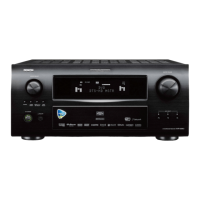
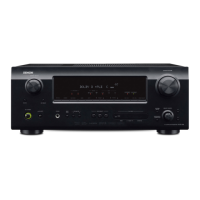
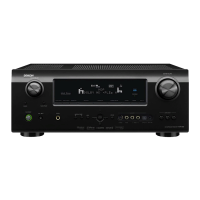
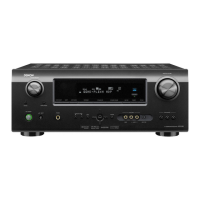
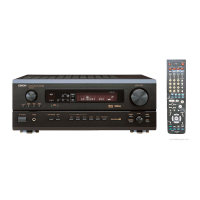
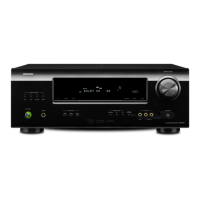
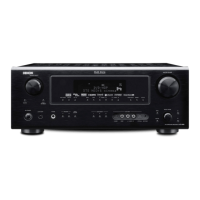
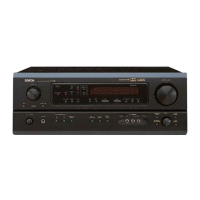
